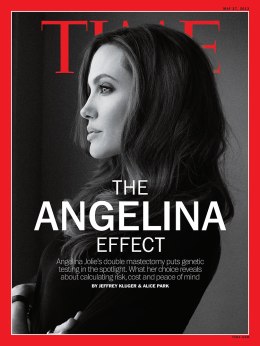
Angelina Jolie has never lacked for influence. When she adopted a baby from Ethiopia, inquiries at U.S. adoption agencies about other Ethiopian orphans doubled. When she named other children Vivienne or Maddox, those names shot up the popularity charts for American newborns. So this week, when a woman known for her powerfully iconic beauty announced that she had undergone an elective double mastectomy to reduce her genetically high risk of breast cancer, it was a cultural and medical earthquake — a revelation so arresting it became the subject of TIME’s newest cover story (visit time.com/angelina to read the story; free for subscribers or purchase a digital pass.
Jolie, by nearly universal agreement, made the right choice for her. She tested positive for the breast-cancer-related BRCA1 gene, putting the probability that she would develop the disease at a terrifying 87%; after her surgery, her doctors put that number at just 5%. But a lot of experts worry that we may overread the lessons. Genetic screening is a young science, and while we may have detected genes linked to a host of ills — Alzheimer’s disease, prostate cancer, rheumatoid arthritis, diabetes, heart disease — we often do a terrible job of calculating our resulting risks. Just over one-tenth of 1% of all women carry the same BRCA mutation Jolie has, and yet doctors expect a stampede of women requesting the test. In the U.S., 36% of women who test positive opt for preventive mastectomy, but some doctors argue that regular MRIs and other screening tests may be sufficient to detect the disease, and that less radical procedures, like lumpectomies, may be sufficient to treat it if it does occur.
(Read Cover Story on The Angelina Effect, Why Her Mastectomy Raises Key Issues About Genes, Health and Risk)
Similar misunderstanding of risks is common in the case of prostate cancer too. The familiar PSA screening test detects blood antigens related to the disease, but levels of the marker can rise as a result of inflammation, infection and even riding a bicycle. Still, many men who test positive begin a cascade of subsequent tests and treatments that can often lead to a radical prostatectomy, sometimes with no real sign that they have the disease, or at least not a slow-growing case they could live with.
Human beings are very good at worrying — it’s what keeps us alive and out of harm’s way. But we’re also good at overworrying, making irreversible decisions to reduce or avoid risks that don’t really exist at all. Jolie’s brave example can make us all smarter and help keep us all healthier — but only if we take the right lessons from it.

